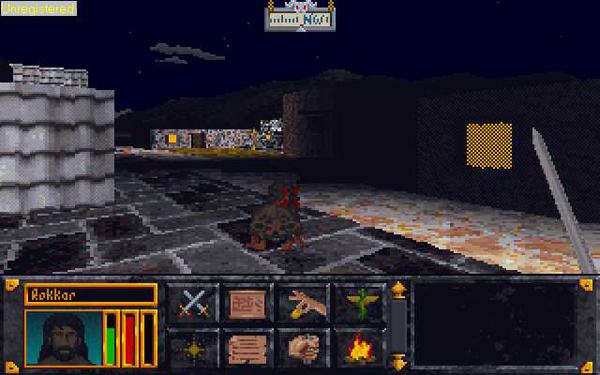In Pictures: A History Of Computer RPGs
The Elder Scrolls: Arena
Year: 1994
Publisher: Bethesda Softworks
Original platform: MS-DOS
The Elder Scrolls: Arena combined the open world concept of games like Wasteland and Ultima VII with the fluid first-person 3D graphics of games like Ultima Underworld into one enormous game. The game’s world was immense and featured a lot of details, such as weather changes, that enhanced immersion. The Elder Scrolls: Arena offered both a linear main quest sequence and the freedom to roam and explore the world, giving the players their choice of how to play the game. It was the first game in the five-part (so far!) Elder Scrolls series. The most recent installment, Skyrim, was released in 2011 and is the last game discussed in this story.
Picture courtesy of MobyGames.com.
Diablo
Year: 1996
Publisher: Blizzard Entertainment
Get Tom's Hardware's best news and in-depth reviews, straight to your inbox.
Original platform: Microsoft Windows
Diablo established the sub-category of computer action role-playing games. Game play was more simplistic compared to earlier computer role-playing games, with only a few, but important, choices for players to make. The most important components were fighting enemies in real time (involving a lot of frantic clicking) and collecting better and better loot. The game also featured a popular multiplayer component. So far, the series consists of two parts, with the third installment, Diablo III, to be released soon.
Picture courtesy of MobyGames.com.
Fallout
Year: 1997
Publisher: Interplay Entertainment
Original platform: MS-DOS and Mac OS
The original Fallout was a top-down perspective game, with the more recent installments featuring a first-person perspective. What set it apart from other games were the sci-fi, post-apocalyptic, and alternate world history ambiance, as well as the quirky style and sense of humor. It is considered the “spiritual” sequel to Electronic Arts’ 1988 Wasteland and is the first in the Fallout series that consists of four games so far, not counting the spin-offs such as Fallout Tactics: Brotherhood of Steel (2001). The most recent game in the franchise, Fallout: New Vegas, was released in 2010.
Picture courtesy of MobyGames.com.
Baldur’s Gate
Year: 1998
Publisher: Interplay Entertainment (developed by BioWare)
Original platform: Microsoft Windows
Baldur’s Gate and its sequel, Baldur's Gate II: Shadows of Amn (2000), as well as its spin-offs Planescape: Torment (1999), Icewind Dale (2000), and Icewind Dale II (2002), are often considered the second “Gold Box” games. They shared the use of the Advanced Dungeons & Dragons rules (now the Second Edition), the Forgotten Realms setting, and party-based game play. The player only created their own character, though, and the other members of the party were pre-made characters (NPCs) that the player met during the game and could invite to join their party. Many players grew attached to these characters, particularly in Baldur's Gate II: Shadows of Amn, as they had unique and interesting personalities. The game also featured a hybrid approach to real-time game play. Even though the game was mostly real-time, the player could pause it using the space key to issue commands at any time, providing a fast option for smaller, easier battles, while retaining a tactical option for larger, harder battles. The games are often considered to be the best adaptation of tabletop role-playing game rules to date.
Picture courtesy of MobyGames.com.
Dragon Age: Origins
Year: 2009
Publisher: Electronic Arts (developed by BioWare)
Original platform: Microsoft Windows
After the Baldur’s Gate series, BioWare went on to develop several similar series, such as Neverwinter Nights, which was based on Dungeons and Dragons Third Edition rules, and the d20-based Star Wars: Knights of the Old Republic series, both of which traded in Baldur’s Gate’s top-down view for a more third-person view (even though the engine still allowed a more “classic” view). Also of note is the Mass Effect series, which features more action elements.
Dragon Age is BioWare’s most current fantasy series. Dragon Age: Origins was followed by Dragon Age II in 2011. The latter was not as well received as the original, as many players felt that it did not feature the same tactical depth as past BioWare fantasy computer RPGs.
Picture courtesy of BioWare.
The Elder Scrolls V: Skyrim
Year: 2011
Publisher: Bethesda Softworks
Original platform: Microsoft Windows
The Elder Scrolls V: Skyrim is the most recent installment in Bethesda’s Elder Scrolls series. All of the hallmark features from the previous installments, such as an immense open world simulation and non-linear game play, are still featured. These are coupled with some of the most advanced graphics in any computer role-playing game to date. Bethesda’s Fallout 3 and Fallout: New Vegas (developed by Obsidian Entertainment) provide a similar, but more sci-fi themed, experience.
Picture courtesy of Bethesda Softworks.
-
godfather666 Nice, never played any of the games before Dragon Age. might check out Baldur's Gate enhanced edition.Reply -
bystander nk102Quite a jump there...Baldur’s Gate to Dragon Age: Origins?I was about to write the same thing.Reply -
yialanliu How do we jump from 1998 to 2009? There were definitely games taht were good in that time period...Reply -
agnickolov Huge gap from 1998 to 2009... I'd put Diablo II on its own in that timeframe, but that might be just me... It was significantly more advanced in game play compared to Diablo and in fact most other action RPGs to stand alone on a hilltop... Even the new Diablo 3 yet to be released seems to pale compared to it (at least according to impressions from the Diablo 3 Beta).Reply -
killerclick No Morrowind, no Oblivion, no KOTOR, no NWN, no Mass Effect... no Might and Magic? Stupid list.Reply





